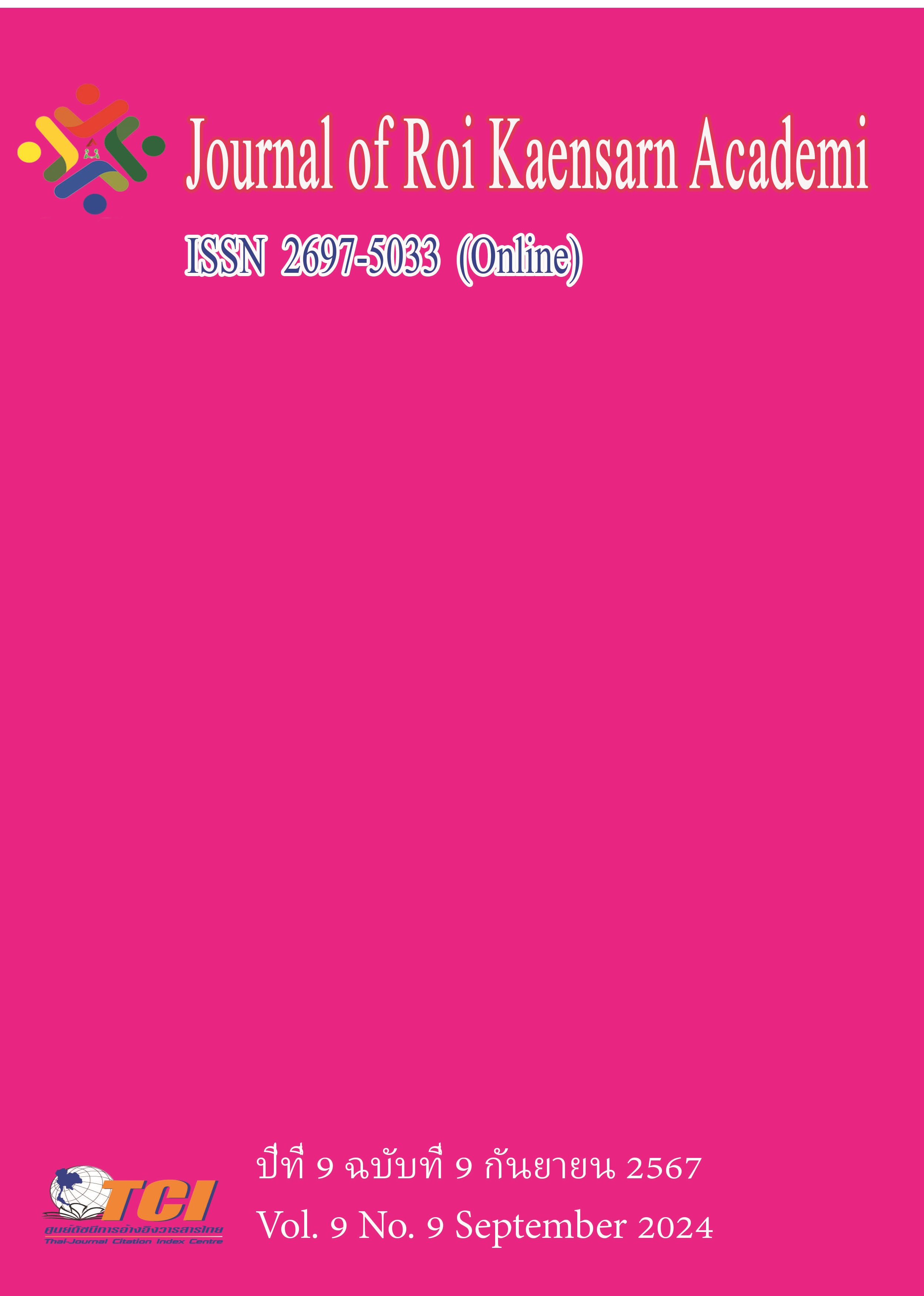The Stakeholder Participation-Based Competency Empowerment Model of Creative Tourism Planning and Management in Phra Nakhon Si Ayutthaya World Heritage Site
Main Article Content
บทคัดย่อ
Phra Nakhon Si Ayutthaya, once the flourishing capital of Thailand, was declared a UNESCO World Heritage site in 1991. Recently, the site has seen a significant influx of visitors, propelled by the success of Thai dramas like Love Destiny Seasons 1 and 2. This popularity has intensified the challenge of managing over-tourism effectively. Addressing these challenges necessitates comprehensive planning and strategic management, including intensive training programs designed to boost the competencies, skills, and knowledge of those involved in tourism planning and management. These efforts aim not only to enhance the area's productivity but also its overall well-being. This study was driven by two primary objectives: 1) to identify and analyze the challenges and obstacles that have previously hindered effective tourism planning and management at the Ayutthaya World Heritage Site, with a particular emphasis on improving creative tourism management; and 2) to enhance the competencies, skills, and knowledge of tourism stakeholders through a creative tourism approach. Employing a mixed-methods strategy, the research involved two groups of 60 participants from six key informant categories, including representatives from central and local governments, the private sector, community sectors, civil society, and academia within Phra Nakhon Si Ayutthaya. The research tools utilized included semi-structured interviews, pre- and post-training assessments, and satisfaction surveys. The investigation uncovered 20 sub-themes, pinpointing the incompetence of manpower and personnel, budget constraints, and ineffective space utilization as the most pressing issues. These challenges have consistently impeded effective tourism management at the site. In response, a three-day intensive training program was developed and executed, significantly bolstering the necessary competencies, skills, and knowledge. The training's impact was profound, with 93% of participants passing the post-training assessment and the majority expressing excellent overall satisfaction. Ultimately, this research lays out a replicable model for developing creative tourism planning and management competencies among tourism stakeholders. This model, adaptable to other locales with similar tourism resources, not only addresses immediate management needs but also establishes a framework for the sustainable development of heritage sites.
Article Details
เอกสารอ้างอิง
Akkarapatkamchai, P., Phuanpoh, Y., Chantanee, M., Mahasumran, W., & Kludcharoen, M. (2023). Developing Creative Tourism Activity Patterns and Routing Tourist Routes, Touching the Charms of the Old City Lifestyle Phra Nakhon Si Ayutthaya Province. Rajapark Journal, 17 (50), 92–104.
Bramwell, B., & Lane, B. (2022). Enhancing the legitimacy and effectiveness of tourism management through collaborative governance models. Journal of Sustainable Tourism, 30 (4), 567-585. https://doi.org/10.1080/09669582.2021.1967269
Chaychun, T., & Intarakumnerd, P. (2022). Building local capacity in creative tourism management. Asian Journal of Tourism Research, 7 (2), 243-259. https://doi.org/10. 13045/j.ajtr.2022.06.01
Duxbury, N., & Richards, G. (2019). Creative tourism and sustainable development. Journal of Cultural Heritage Management and Sustainable Development, 9 (1), 25-40. https://doi.org/10.1108/JCHMSD-06-2018-0042
González, M., & Medina, F. (2021). Strategies for cost-effective management of heritage sites. International Journal of Heritage Studies, 27 (3), 315-329. https://doi.org /10.1080/13527258.2020.1805846
Guttentag, D. (2022). Challenges in managing cultural heritage sites in the face of over- tourism. Tourism Management, 88, 104398. https://doi.org/10.1016/j.tourman.2021 .104398
Hartwell, H., Smith, M., & Page, S. (2022). The intersection of stakeholder participation, competency empowerment, and creative tourism in heritage sites. Tourism Review, 77 (4), 1025-1038. https://doi.org/10.1108/TR-03-2021-0120
Jiratchot, C. (2021). Challenges in coordinating stakeholders in tourism management. Tourism Planning & Development, 18 (2), 143-160. https://doi.org/10.1080/21568 316.2020.1822574
Li, Y., & Hunter, C. (2021). The pressures of mass tourism on cultural heritage sites. Annals of Tourism Research, 90, 103130. https://doi.org/10.1016/j.annals.2021.103130
Lalicic, L., & Önder, I. (2018). The role of stakeholder collaboration in sustainable tourism. Journal of Destination Marketing & Management, 9, 158-167. https://doi.org/10. 1016/j.jdmm.2017.12.003
Matiku, S., et al. (2021). Budget constraints in heritage tourism management. Journal of Heritage Tourism, 16 (5), 442-456. https://doi.org/10.1080/1743873X.2020.1859782
Nunkoo, R. (2017). Stakeholder participation in sustainable tourism development. Tourism Management Perspectives, 23, 111-122. https://doi.org/10.1016/j.tmp.2017.06.011
OECD. (2022). Promoting sustainable tourism practices. Organisation for Economic Co- operation and Development. https://doi.org/10.1787/9e96bd67-en
Richards, G. (2020). Creative tourism: Definitions, concepts, and relevance. In D. Macleod & J. Carrier (Eds.), Tourism, creative industries, and cultural economies (pp. 45-66). Routledge. https://doi.org/10.4324/9780429057043
Richards, G., & Marques, L. (2021). Developing creative tourism offerings. Tourism Management, 87, 104388. https://doi.org/10.1016/j.tourman.2021.104388
Richards, G., & Wilson, J. (2007). Developing creative tourism offerings. In G. Richards & J. Wilson (Eds.), Tourism, creativity, and development (pp. 1-32). Routledge.
Ruhanen, L., et al. (2021). Sustainable tourism outcomes through stakeholder collaboration. Journal of Sustainable Tourism, 29 (9), 1387-1403. https://doi.org/10.1080/0966958 2.2020.1848098
Sawasdee, S., & Yodsuwan, A. (2021). Stakeholder participation in creative tourism planning in Phra Nakhon Si Ayutthaya. Journal of Tourism Studies, 32 (2), 155-173. https://doi.org/10.1016/j.jots.2020.09.001
Smith, M., & Pappalepore, I. (2022). The role of creative tourism in mitigating the negative impacts of mass tourism. Journal of Tourism and Cultural Change, 20 (1), 87-102. https://doi.org/10.1080/14766825.2021.1912549
Thongpan, S., & Tirasatayapitak, K. (2022). The role of local artisans in sustainable creative tourism development. Journal of Heritage Tourism, 17 (4), 278-294. https://doi.org/10.1080/1743873X.2021.1936854
Training Industry. (2022). Best practices in tourism training programs. Training Journal, 59 (3), 56-67. https://doi.org/10.2307/trainingjournal.2022.3
UNESCO. (1991). Phra Nakhon Si Ayutthaya: A World Heritage Site. Online. Retrieved from https://whc.unesco.org/en/list/576/
UNESCO. (2023). Innovation in heritage site management. Online. Retrieved from https://whc.unesco.org/en/activities/1147/
Vasquez, C., & Chandra, Y. (2022). Empowering local communities through competency development in tourism. Community Development Journal, 57 (1), 75-91. https://doi.org/10.1093/cdj/bsab021
Wisudthiluck, S., Sindcharak, T., Sangnit, N., & Noithammaraj, P. (2015). Creative Tourism in Thailand: Problems and Obstacles Case Studies of Ceramic and Cotton Quilt Making. Thammasat Review, 17 (1), 168–179.
Wongpun, K., & Bhatiasevi, V. (2023). Government policies and stakeholder empowerment in Ayutthaya’s tourism sector. Journal of Policy Research in Tourism, Leisure and Events, 15 (2), 203-218. https://doi.org/10.1080/19407963.2022.2057482
World Bank. (2022). Funding opportunities for heritage conservation. Heritage Management Review, 12 (4), 39-52. https://doi.org/10.1080/19407963.2021.1948752
World Economic Forum. (2024). Global tourism industry competitiveness report. World Economic Forum Reports. https://www.weforum.org/reports/global-tourism- competitiveness-report-2024/
Zehrer, A., & Raich, F. (2021). Competency empowerment in tourism management. Tourism Management, 84, 104247. https://doi.org/10.1016/j.tourman.2021.104247

